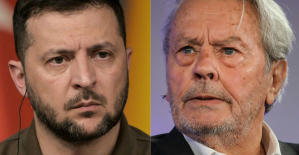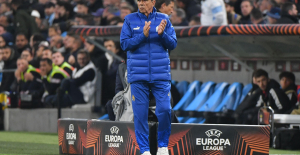Bibiana Beglau is in the forest. Every now and then you hear a bird whistle. The connection drops every now and then. One hopes that she doesn't get lost. The one with the forest fits quite well. Beglau discovered a penchant for odysseys as she pondered the books of her life. Her career has completely lacked the element of odyssey, because it is almost frighteningly straightforward: almost since she left the Hamburg drama school in the mid-1990s, Beglau, born in Braunschweig in 1971, has been one of the great contemporary German actresses, in numerous film and television productions as well as on all well-known stages, from Düsseldorf to the Vienna Burgtheater. At this year's Ruhrtriennale, she was seen in a grandiose double role in Barbara Frey's production of Schnitzler's "The Wide Land". Here she tells us which books Beglau is interested in.
It was a difficult decision between The Very Hungry Caterpillar and Benjamin the Donkey, as far as the most important book of my childhood is concerned. I'm arguing a bit. But I couldn't help it. Because Hans Limmer's "My Esel Benjamin" is the story of an odyssey and odysseys fascinate me in particular, as I'm just realizing while I'm thinking about the books of my life. "My Donkey Benjamin" tells the story of a little girl who meets a donkey. They become friends and decide to go for a walk to discover the world together. They are on the road without a commission from the gods, driven only by curiosity. On this first voyage of discovery, they promptly get lost and lost. The black and white photographs accompanying the story in the book are austere and clear - they convey the bleakness, the heat and the hardship. One sees stones there over which soft children's feet and wobbly hooves stumble, barrenness, hopelessness. The girl in the white coat is crying, and the baby donkey is not feeling well either. It is said that children prefer colorful things. I liked the austerity in this book, the loneliness - and how you get your first glimpse of what it's like to get lost in this world. But this odyssey ends in the arms of the parents. It's about finding a friend and mastering a first adventure.
From a certain age I was on the lookout for passages in Henry Miller's books that were harmful to young people. And then I read a completely different Henry Miller in The Smile at the Bottom of the Ladder. It's a clown's story. He's an idealist, sits in a circus tent and has come up with a completely absurd performance. At the foot of a ladder he crouches under a moon that is a searchlight. He sits there and tries to give people an inner happiness, not to make them laugh anymore, but to make them smile. But the longer this lasts, the more he falls into a trance, smiles mysteriously Buddhist to himself and does nothing at all. Eventually people start giggling. But that is not the smile of bliss that he wished for, but a hysterical laugh, in the end even a laugh. And then there were these drawings by Miró, which I didn't understand at all at the time - maybe not even now. But here I saw the collaboration of two different arts for the first time and understood how both correspond in their own way. It fascinates me to this day.
When “Irre” fell to me, I was already at the Hochschule für Theater und Musik in Hamburg. I couldn't cope with the day-to-day drama school life at all. And then there was this book. And this language. This precision, this modernity, this staccato in the description. In "Irre" you don't actually know who is infecting whom in society - or whether society itself is sick? Do doctors first evoke the disease or are they infected by the lunatics? I often saw Rainald Goetz in Berlin when I was there. He often sat at the counter of the "Tresor" and stared straight ahead. He had such yellow, fluffy hair back then. That's this author, I thought to myself, who writes these things, and at night there's a "boom-boom-boom" on the concrete walls and in people's heads. It rumbles and bodies tremble. And he is able to describe this hopelessness in such a way. "Irre" was the first time I had anything to do with literature that describes my generation. Although he wrote that much earlier. That's not a nineties yearbook, it's from 1983. Completely crazy. "Irre" was formative for me and my generation, like Christian Kracht's "Faserland". Since then, Goetz has accompanied me as an author. And I've never learned to hate him, although I'm always shocked to see how precisely he, the absolute realist, has my generation in his sights.
Thomas Harlan is the son of Veit Harlan, who shot Jud Suess for Goebbels. Thomas Harlan could never escape his cruel father and always tried, well, not to understand, but to understand. “Rosa” is a strange text that is never entirely understandable, always lurking around in secret. But if you want to understand the time of the Third Reich, the absolute annihilation and the black sun, then you will nowhere come as close to this understanding as here. Harlan is not describing how something like this could have happened, but our actually desperate inner state of wanting to understand. It starts like a fairy tale. With a couple living in a mound of earth. In the ashes of an extermination camp where the man was a Nazi henchman. Now he can't get away from it. He still has a zinc bucket with wedding rings and broken gold teeth in it. And then there are – this story is also one of an odyssey – a handful of filmmakers who want to do some work to come to terms with it. You will find a record from a pulmonary hospital. These are voice recordings that you really can't understand. And which Thomas Harlan wrote down as well. There are words that you can't read, they sound like "krrrrchgschpfff// ... //grrrgssahm". And yet it turns out to be a story. An extremely brutal one. Someone (maybe it was him himself) shot off the lower jaw of the soldier who is speaking but actually can't. "Rosa" is an eloquent masterpiece about speech resolution. A very painful book, actually the only one I know in which the soul processing and the soul labyrinth and the soul dissolution become language in such a way. “Rosa” also taught me to understand that language does not have to follow the logic of words. And that punctuation marks are the gestures of language. To this day, this book accompanies me when I start to work on texts for readings: not omitting a comma, not omitting a period. Read for the punctuation marks until the writer shows himself behind them. The punctuation marks are the rhythm, the breath of the writer.
I've always been a big fan of photography. One day in Zurich I got my hands on this Nan Goldin ribbon. In it, Goldin uses photographs to tell of a world I knew from Christiane F. They are images of social misery taken with a deep understanding of ways of life that are outside of norms, wild, deviant lives, with a different form of gender. Lots of tender and also solidarity images that can only come about if you feel a deep inner kinship with those depicted. Death always seems to be there with all the characters, like a loitering guest. What fascinated me about this volume is that biographical photography does not necessarily imply committing treason, because with Nan Goldin it never becomes soul pornography. Even in intimate scenes, she always keeps a loving distance. And then there is this effect: if you look at the pictures for a longer period of time, they move. Although each photo makes the second of the captured gesture visible, the gesture becomes more alive the longer you look at it. The pictures move you and – I mean that quite physically – demand a movement. This book will never disappear in the depths of my bookcase. It is always within reach.
Others have the Bible, I have Roberto Bolaño's "2666". I never finish with that. Perhaps it's because the novel was never actually finished, as Bolaño died while writing it. The individual parts are almost books in themselves. In the story, paths cross, mirror and intersect. Bolaño creates very surrealistic and at the same time realistic and fantastic pictures, populated with figures that seem so strange and always leave me unredeemed in the unredeemed, mysterious world of 2666 that I will probably read this book anew and differently in every phase of my life.
Summer in Berlin. The city is empty, hot and sluggish, it radiates a dull eroticism. You do things at night that make you suffer a bit afterwards, asking yourself whether it really should have been. Such a story is "The Flower Caster", contained in the collection of stories "The Author's Widow". It's about a woman watering flowers for people who are on vacation. And as it is: She looks around in the boxes and boxes. In an apartment she finds polaroids of women posing in cheap lingerie. At the back there is always a name and a year “Steffi 1983” or “Nadja 2000” and so on. And then you learn how the flower potter herself becomes a name and a year. The sluggishness, the mugginess, the easy-going ease with which the story is written - that's Berlin in the summer for me, again and again. This strange form of eroticism, this wonderful wink – I would love to see that made into a film. Would probably have to do French. I think they can do that.
I met Anne Deuter after an evening at the theater. She said she was a book artist. I had never heard of book art and had no idea what the term encompassed until she showed me one of her works. The book was called “Mustard Yellow”. When you open the book, at first there are no texts, no pictures – just blank pages. But you can feel letters as a delicate embossing as you run across the pages. The text becomes legible by taking the pencil provided and carefully shading the pages like you did when you were a child. But you have to have the courage to do that first, because the material, the paper, feels so valuable. Then, when you've hatched long enough, been brave enough, you read texts about something hidden. In the case of a father existing as a myth, mysterious remains in a daughter's lyrical mind. A very delicate work that teaches you the value of paper as well as words. An art form with great sensual imagination.
Another odyssey. This time one through Berlin. The expressive city in extra super conversion, always has been. Even back than. Now too. On the way in Berlin one can still find remnants of the world of Franz Biberkopf. Old butcher shop signs, toothpaste advertising. "Berlin Alexanderplatz" is pure expressionism. Everything is there: observation of an impoverished society, thriller, advertising, Bible texts, unemployment, pathos, sometimes a bundle of language cascades. Right in the middle Franz Biberkopf, the Berlin Odysseus. A naïve, a madman who kills a woman, loses an arm. A total loser. And if he wants to die, even death waves him away: "Just leave me alone, I don't want anything to do with you, you can go on living alone." Even death doesn't want such an asshole to be a gift. Döblin's text was inspired by a time when people died quickly and a lot, when life was worth less than it is today. The story inspired me in its tragedy. I always like the fact that the text jumps like that, constantly changing its style. Just like the language. The story of the male friendship between Franz and Reinhold that ended in death. And that you notice that Berlin hasn't actually changed at all. The whore Babylon, she still exists.
"Journey to the End of the Night" is an odyssey. And again expressionism. This time in World War I. The story of a braggart - and that's what Odysseus really is - who is condemned to sacrifice his life to wanderings. Out of boredom and dullness, the main character, a medical student, decides to go to the French front and starts digging away until she quickly realizes that war is deadly and deserts, which is also deadly. The only way out of this dilemma is to flee, to Africa, to America, back to France. And Celines Odysseus, whose name is Bardamu as a person and as a doctor, always fails. A man who doesn't move, who can't change anything, who sees and describes grievances and gets stuck in himself. "Journey to the End of the Night" is the reckoning with a sluggish, decaying society. In a language that comes from below in such a way that the tempo just squirts. A filthy language for a filthy society where there is only filth. If you don't already hate people, you should read this. But you couldn't hate people so well if you didn't love them at the same time - and that's the tragedy of a journey to the end of the night. That you can hate a character so much and at the same time think: That's exactly what we are, we all behave just as stupidly. Except for Greta from Sweden. She does it differently. But there must be a few little lights on this globe, which is a mess.

 Sydney: Assyrian bishop stabbed, conservative TikToker outspoken on Islam
Sydney: Assyrian bishop stabbed, conservative TikToker outspoken on Islam Torrential rains in Dubai: “The event is so intense that we cannot find analogues in our databases”
Torrential rains in Dubai: “The event is so intense that we cannot find analogues in our databases” Rishi Sunak wants a tobacco-free UK
Rishi Sunak wants a tobacco-free UK In Africa, the number of millionaires will boom over the next ten years
In Africa, the number of millionaires will boom over the next ten years Can relaxation, sophrology and meditation help with insomnia?
Can relaxation, sophrology and meditation help with insomnia? WHO concerned about spread of H5N1 avian flu to new species, including humans
WHO concerned about spread of H5N1 avian flu to new species, including humans New generation mosquito nets prove much more effective against malaria
New generation mosquito nets prove much more effective against malaria Covid-19: everything you need to know about the new vaccination campaign which is starting
Covid-19: everything you need to know about the new vaccination campaign which is starting For the Olympics, SNCF is developing an instant translation application
For the Olympics, SNCF is developing an instant translation application La Poste deploys mobile post office trucks in 5 rural departments
La Poste deploys mobile post office trucks in 5 rural departments Meta accelerates into generative artificial intelligence with Llama 3
Meta accelerates into generative artificial intelligence with Llama 3 In China, Apple forced to withdraw WhatsApp and Threads applications at the request of the authorities
In China, Apple forced to withdraw WhatsApp and Threads applications at the request of the authorities The main facade of the old Copenhagen Stock Exchange collapsed, two days after the fire started
The main facade of the old Copenhagen Stock Exchange collapsed, two days after the fire started Alain Delon decorated by Ukraine for his support in the conflict against Russia
Alain Delon decorated by Ukraine for his support in the conflict against Russia Who’s Who launches the first edition of its literary prize
Who’s Who launches the first edition of its literary prize Sylvain Amic appointed to the Musée d’Orsay to replace Christophe Leribault
Sylvain Amic appointed to the Musée d’Orsay to replace Christophe Leribault Skoda Kodiaq 2024: a 'beast' plug-in hybrid SUV
Skoda Kodiaq 2024: a 'beast' plug-in hybrid SUV Tesla launches a new Model Y with 600 km of autonomy at a "more accessible price"
Tesla launches a new Model Y with 600 km of autonomy at a "more accessible price" The 10 best-selling cars in March 2024 in Spain: sales fall due to Easter
The 10 best-selling cars in March 2024 in Spain: sales fall due to Easter A private jet company buys more than 100 flying cars
A private jet company buys more than 100 flying cars This is how housing prices have changed in Spain in the last decade
This is how housing prices have changed in Spain in the last decade The home mortgage firm drops 10% in January and interest soars to 3.46%
The home mortgage firm drops 10% in January and interest soars to 3.46% The jewel of the Rocío de Nagüeles urbanization: a dream villa in Marbella
The jewel of the Rocío de Nagüeles urbanization: a dream villa in Marbella Rental prices grow by 7.3% in February: where does it go up and where does it go down?
Rental prices grow by 7.3% in February: where does it go up and where does it go down? With the promise of a “real burst of authority”, Gabriel Attal provokes the ire of the opposition
With the promise of a “real burst of authority”, Gabriel Attal provokes the ire of the opposition Europeans: the schedule of debates to follow between now and June 9
Europeans: the schedule of debates to follow between now and June 9 Europeans: “In France, there is a left and there is a right,” assures Bellamy
Europeans: “In France, there is a left and there is a right,” assures Bellamy During the night of the economy, the right points out the budgetary flaws of the macronie
During the night of the economy, the right points out the budgetary flaws of the macronie These French cities that will boycott the World Cup in Qatar
These French cities that will boycott the World Cup in Qatar Europa League: “We dream of everything,” says Jean-Louis Gasset
Europa League: “We dream of everything,” says Jean-Louis Gasset Europa League: “Trouble playing our football,” admits Benfica coach
Europa League: “Trouble playing our football,” admits Benfica coach Europa League Conference: “Martinez eats all your deaths”, Obraniak’s breakdown after the elimination of Lille
Europa League Conference: “Martinez eats all your deaths”, Obraniak’s breakdown after the elimination of Lille Premier League: “It’s a team that is transforming into the Champions League”, Casemiro returned to Real’s qualification
Premier League: “It’s a team that is transforming into the Champions League”, Casemiro returned to Real’s qualification


















